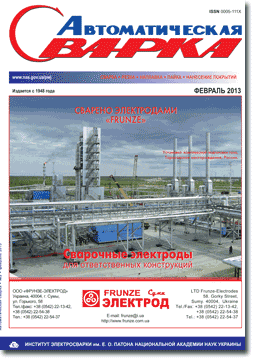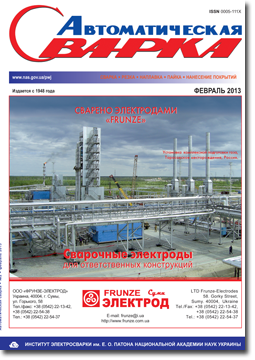| 2013 №02 (08) | 2013 №02 (10) |

«Автоматическая сварка», 2013, № 2, с. 49-53
ВЛИЯНИЕ КАЧЕСТВА ПОВЕРХНОСТИ КРОМКИ СОЕДИНЕНИЯ НА ЭФФЕКТИВНОСТЬ ЛАЗЕРНОЙ СВАРКИ НИЗКОЛЕГИРОВАННЫХ СТАЛЕЙ
М. СОКОЛОВ, А. САЛМИНЕН
Технологический университет, г. Лаппеенранта, Финляндия. E-mail: mikhail.sokolov@lut.fiРеферат
Лазерные технологии находят все более широкое применение в промышленности. Многие публикации посвящены повышению эффективности применения лазерной сварки, особенно с глубоким проплавлением, на которую влияют различные параметры процесса. В данной работе изучено влияние шероховатости кромки и наличия зазора при выполнении стыковых соединений пластин из низкоуглеродистой Ст3 толщиной 20 мм. Сварку выполняли волоконным лазером мощностью 14 кВт с длиной волны 1070 нм. Эксперименты проводили в два этапа: на первом выполнили сварку пластин толщиной 16 мм с уровнем шероховатости Ra 2 мкм при скорости сварки 1...2 м/мин, мощности лазера 12...14 кВт и положением фокусной точки — 7,5 мм; на втором изменяли шероховатость кромки и зазор в стыке при скорости сварки 2 м/мин, мощности лазера 14 кВт и том же положении фокусной точки. Отмечено увеличение глубины проплавления до уровня шероховатости Ra 6,3 мкм с дополнительным зазором. Доказано, что роль шероховатости поверхности кромки имеет значительное влияние при возникновении парогазового канала (изменяется модель повторного отражения на кромке стыка). На этапе проектирования изделий, изготовляемых с использованием стыковой сварки лазерным излучением, необходимо учитывать оба фактора.
Библиогр. 26, рис. 4.
Ключевые слова: лазерная сварка, низколегированная сталь, волоконный лазер, высокая мощность, коэффициент поглощения, глубина проплавления, зазор, шероховатость поверхности кромки
Поступила в редакцию 07.12.2012
Опубликовано: 24.01.2013
1. Duley W. W. Laser welding. — New York: John Wiley & Sons Inc., 1998. — 253 p.
2. Ion J. C. Laser processing of engineering materials. — Oxford: Butterworth-Heinemann, 2005. — 576 p.
3. Xiangzhong J. A three-dimensional model of multiple reflections for high-speed deep penetrafition laser welding based on an actual keyhole // Optics and Lasers in Eng. — 2008. — 46, № 1. — P. 83–93.
4. Blondeau R. Metallurgy and mechanics of welding processes and industrial applications. — Saint-Etienne: ENSM, 2008. — 512 p.
5. Analysis of hybrid Nd:Yag laser-MAG arc weiding processes / L. Guen, R. Fabbro, M. Carin et al. // Optics & Laser Technology. — 2011. — 43, № 7. — P. 1155–1166.
6. Kah P., Salminen A., Martikainen J. Laser-arc hybrid welding processes (review) // The Paton Welding J. — 2010. — № 6. — P. 32–40.
7. Bayraktar E., Moiron J., Kaplan D. Effect of welding conditions on the formability characteristics of thin sheet steels: Mechanical and metallurgical effects // J. Mat. Proc. Technol. — 2006. — 286, № 3. — P. 20–26.
8. Arata Y., Miyamoto I. Some fundamental properties of high power laser beam as a heat source (Report 2) // Transactions of the Japan Welding Society. — 1972. — № 3. — P. 163–180.
9. Laser welding of stainless steel: Influence of the edges morphology / L. Covelli, F. Jovane, L. De Lori V. Tagliaferri // CIRP Annals — Manufacturing Technology. — 1988. — № 37. — P. 545–548.
10. Ricciardi G., Cantello M. Laser material interaction: Absorption coefficient in welding and surface treatment // Ibid. — 1994. — 43, № 1. P. 171–175.
11. Grigoryants A. G., Shiganov I. N. Misyurov A. I. Technological processes of laser treatment. — Moscow: Bauman Molcow State Technical University. — 2006. — 663 p. — In Russian.
12. Steen W. M. Laser material processing. — 3 ed. — London: Springer, 2003. — 408 p.
13. Phenomena of welding with high-power fiber laser / K. Kinoshita, M. Mirutani, Y. Kawahito, S. Katayama // Proc. Of 25th Intern. Congress applications of lasers & electro-optics, 2006. — P. 535–542.
14. Weld penetration and phenomena in 10 kW fiber laser welding / S. Katayama, K. Kinoshita, Y. Kawahito et al. // Ibid. — 2007. — P. 360–369.
15. Salminen A., Lehtinen J., Harkko P. The effect of laser and welding parameters on keyhole and melt pool behavior during fiber laser welding // Ibid. — 2008. — P. 416–425.
16. Salminen A., Piili H., Purtonen T. The characteristics of high power fibre laser welding // Proc. of the Institution of Mechanical engineers, Part C // J. Mech. Eng. Sci. — 2010. — 224, № 5. — P. 1019–1029.
17. Salminen A., Purtonen T. The effect of welding parameters on keyhole and melt pool dimensions and behavior during fiber laser welding // 12th Nordic conf. on laser materials processing. — NOLAMP 12, 2009. — 16 p.
18. Kaplan A., Wiklund G. Advanced welding analysis methods applied tojieavy section welding with a 15kW fiber laser // Intern. conf. on welding of the IIW. — 2009. — 53. — P. 295–300.
19. Katajama S., Kawahito Y., Mizutani M. Elucidation of laser welding phenomena and factors affecting weld penetration and welding defects // Phys. Procedia. — 2010. — № 5. — P. 9–17.
20. Laser welding and weld analysis of thick sectfon S355 structural steel / M. Sokolov, A. Salminen, M. Kuznetsov, I. Tsibulskiy // Materials @ Design. — 2011. — 32, № 10. — P. 5127–5131.
21. Bergstrom D., Powell J., Kaplan A. The absorption of light by rough metal surfaces. A three-dimensional ray-tracing analysis // Proc. of 26th Intern. congress on applications of lasers & electro-optics. — 2007. — P. 704–713.
22. Malashenko A. A., Mezenov A. V. Laser welding of metal. — M.: Mashinostroenie, 1984. — 45 p. — In Russian.
23. Laser welding of structural steels: Influence of the edge roughness level / M. Sokolov, A. Salminen, V. Somonov, A. Kaplan // Optics & Laser Technology. — 2012. — 44, № 7. — P. 2064–2071.
24. GOST 380–94. Common quality carbon steel // Grades. — 1994. — In Russian.
25. EN 10049:2005. Measurement of roughness average. Ra and peak count RPc on metallic flat products. — 2005.
26. ISO 13919-1:1996. Welding. Electrons and laser beam welded joints // Guidance on quality levels for imperfections. — Part 1: Steel. — 1996.
The cost of subscription/purchase order journals or individual articles
| Journal/Currency | Annual Set | 1 issue printed |
1 issue |
one article |
| TPWJ/USD | 384 $ | 32 $ | 26 $ | 13 $ |
| TPWJ/EUR | 348 € | 29 € | 24 € | 12 € |
| TPWJ/UAH | 7200 UAH | 600 UAH | 600 UAH | 280 UAH |
| AS/UAH | 1800 UAH | 300 UAH | 300 UAH | 150 UAH |
| AS/USD | 192 $ | 32 $ | 26 $ | 13 $ |
| AS/EUR | 180 € | 30 € | 25 € | 12 € |
| SEM/UAH | 1200 UAH | 300 UAH | 300 UAH | 150 UAH |
| SEM/USD | 128 $ | 32 $ | 26 $ | 13 $ |
| SEM/EUR | 120 € | 30 € | 25 € | 12 € |
| TDNK/UAH | 1200 UAH | 300 UAH | 300 UAH | 150 UAH |
| TDNK/USD | 128 $ | 32 $ | 26 $ | 13 $ |
| TDNK/EUR | 120 € | 30 € | 25 € | 15 € |
AS = «Automatic Welding» - 6 issues per year;
TPWJ = «PATON WELDING JOURNAL» - 12 issues per year;
SEM = «Electrometallurgy Today» - 4 issues per year;
TDNK = «Technical Diagnostics and Non-Destructive Testing» - 4 issues per year.





